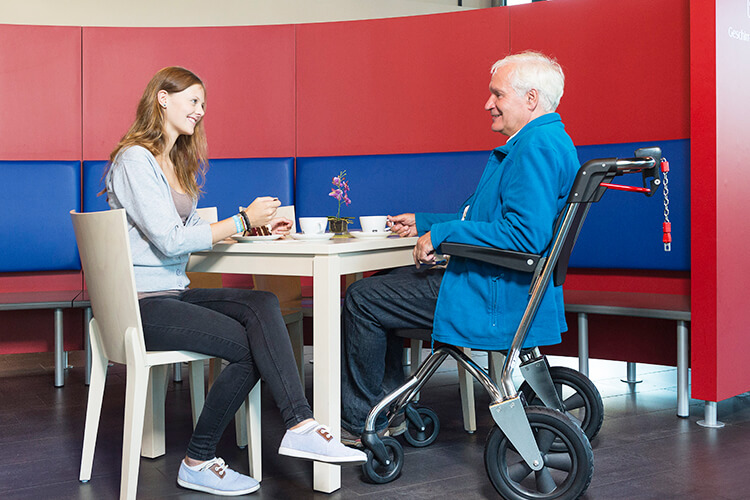Implementing inclusion: advice for owners of restaurants and other facilities

The term “inclusion” has gained more and more attention recently. In the field of education as well as in the wider public, the social integration of people with disabilities plays an ever greater role. Learn here what exactly inclusion means and how you can ensure disabled access for your facility.
Accessibility at public facilities is still not a matter of course in many places. It is consequently very important for owners of restaurants or cultural facilities to examine this topic in more detail. Become a pioneer and allow successful inclusion at your facility!
What is inclusion?
In 2008, the UN Convention on the Rights of Persons with Disabilities declared inclusion to be a human right for people with disabilities. This refers to the self-determined participation in social activities for all people.
For people with certain limitations, for example with regard to mobility, this means that they are not integrated into existing structures or have to adapt to their environment. Instead, this environment should be set up so that all people – with or without disabilities – can live in equality.
In Germany, inclusion has so far mostly been implemented in the education sector. Inclusive schools are equipped to accommodate pupils with and without disabilities in joint classes. According to a study by the Bertelsmann Foundation, however, inclusion is not yet very widespread in Germany overall.
One more reason to become a pioneer and create more accessibility at your own facility! The following sets out what you need to know about accessibility and how to implement it at your food service or cultural facility.
Accessibility – what exactly does that mean?
The term “accessibility” has become increasingly important since the 1990s. Accessible building design has become an important aspect in public facilities as well as in private residences. Because accessibility makes life easier not only for people with disabilities, but also for older people, chronically ill patients and families with small children (with prams).
Accessibility therefore means designing living spaces so that everyone can access and use them independently and without help from othersschat, as far as possible.
Accessibility refers not only to access paths to public facilities or private living quarters, though. Official forms and web pages also have to made accessible, for example by being written in plain language. Deaf people require a sign language interpreter for speeches and talks.
Accessibility is a great opportunity for restaurants, shopping centres and cultural facilities. If you design your facilities so that everyone has equal access, you can greatly expand your target group.
7 tips: How to make inclusion possible!
The following tips tell you how you can implement accessibility and create space for inclusion.
Tip 1: Install a permanent or mobile wheelchair ramp
A wheelchair ramp makes access your facility easier for people who are permanently or temporarily in a wheelchair or who use a wheeled walker or a transfer chair (see tip 7).
Such a ramp can already be planned during construction so that it then runs, for example, parallel to the stairs.
As an alternative, you can offer your visitors a mobile wheelchair ramp, which is placed on the stairs when needed. A mobile ramp requires, however, that the disabled person always has someone with them who puts the ramp in place (with your help, if necessary).
It is still a good solution, though, if maybe you are already well established in your space and now want to upgrade to more accessibility.
Tip 2: Also provide documents in plain language …
Whether menus at restaurants, descriptions of exhibits at museums or show programs at theatres – any document can only be read and understood by everyone if it is also available in plain language.
People with learning disabilities or dyslexia can then also understand everything and are not shut out.
Guidance on plain language is available from various sources. There are special rules for writing documents in plain language. If you would like expert support, you can contact the respective associations for services such as editing texts or training.
Tip 3: …and in Braille
People with visual impairments also want to take part in social life. It is therefore advisable to offer documents in Braille as well.
Restaurant owners, for example, can offer their guests Braille menus. This makes ordering easier for your guests and ensures that they will happily return.
Tip 4: Add images to text
Surely you also want people with dyslexia or learning disabilities to also enjoy their visit and to recommend your business to others? We therefore recommend adding images to text at restaurants and at cultural facilities such as museums – visualisations are easier to understand for many people, making complex issues more accessible.
Examples for images:
- At restaurants: Integrate photos into the menu, showing the dishes. This allows guests to identify what is being offered without having to read the text.
- At hotels: Don’t just place a service description in hotel rooms, but ideally also a photo folder. This contains photographs of each relevant room and escape route, allowing your guests to identify these directly and find their way around.
- At shopping centres: In addition to a map with the names of the individual shops, also mark each one with a symbol: shoes, trousers, dresses, glasses, jewellery, make-up – there are many options. People with dyslexia can interpret these symbols to find out where they can shop.
Tip 5: Install an accessible toilet
Toilets are facilities which all people should be able to use independently. That is why public spaces are required to have at least one disabled toilet.
Disabled toilets are equipped in such a way that wheelchair users as well as people with physical disabilities and blind people can use it. The relevant building regulations define how disabled washrooms have to be equipped.
Public facilities can take an important step towards inclusion and accessibility by providing disabled toilets. This shows understanding and respect for your guests.
Tip 6: Design an accessible website
Digital spaces also have to be made accessible so they can really be understood by everyone. This applies to people with or without disabilities as well as to older people, who are also increasingly using the Internet.
Accessible website design, however, requires a certain basic knowledge of accessibility on the web. After all, content should be made accessible to everyone: people with hearing, visual, cognitive or motor function impairments, inexperienced users and older people.
Tip 7: Offer transfer chairs for hire
Do you know SAM? The transfer chair from Provita is another way to offer more accessibility at your facility. SAM stands for “sit and move”, which perfectly describes the functions of the transfer chair:
- Your guests can sit down comfortably when they need a little rest.
- The transfer chair is very agile, easy to move around and supports people with limited mobility.
- And yet SAM is highly robust and sturdy – quality “made in Germany”.
Transfer chairs are ideal for improving the experience of your guests, especially at shopping centres, museums, restaurants and other cultural facilities. The SAM can be : The transfer chair is released with a coin or card and then returned after use.
SAM is therefore a good alternative to a wheelchair for guests with restricted mobility (for example after a sports injury) as well as for older people and pregnant women. The transfer chair can be used for a short period without placing restrictions on the user.
Additional advice: Hire a sign language interpreter
Especially for public speeches and talks, you should also consider those guests who are deaf or hard-of-hearing. A sign language interpreter can help accommodate these people.
Sign language is a type of visual communication which is used especially by deaf or hard-of-hearing persons. Gestures and facial expressions play a crucial role in this. A sign language interpreter therefore translates from the spoken language into sign language, allowing all guests to understand all presentations.
Some owners of restaurants or cultural facilities may not be able to implement all these measures in one go. But you can still take small steps towards inclusion and accessibility by, for example, integrating more mobility into your services to allow everyone equal access to your facilities.
Our bottom line on inclusion and accessibility
People with disabilities sometimes find it difficult to participate in social events: there is no wheelchair access, menus for blind people are not available and speeches are not translated into sign language.
Inclusion is intended to prevent that. According to this human right for people with disabilities, each living space should be designed from the outset so that everyone can participate independently and in a self-determined manner.
This means that, for example, a wheelchair ramp should be installed next to stairs, that disabled toilets are available in public spaces and that documents in plain language are available for people with learning disabilities.
As the owner of a restaurant or cultural facility, you can take a step towards inclusion and accessibility by also ensuring added mobility. The SAM transfer chair offered by Provita can be hired by your guests flexibly at any time.
It is modern, elegant, very mobile and highly sturdy. A good alternative support especially for people with temporary physical limitations, older people and pregnant women!
Would you like to meet SAM? Test the transfer chair from Provita without obligations!





